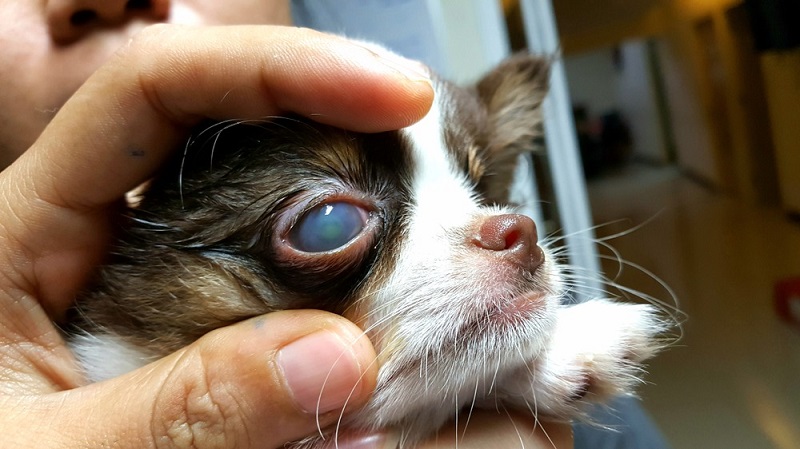Your dog’s eyes are not just windows into their soul but also crucial physical health indicators. In this blog, Canvas Personalized will explore all aspects of dog eye problems. We will review the causes, symptoms, and treatment choices, from minor irritations like redness and discharge to major diseases like cataracts and glaucoma. We’ll also advise on preventative care to keep those puppy-dog eyes sparkling. This blog is your go-to source for comprehending, controlling, and ensuring the well-being of your four-legged family member, whether you’re a passionate pet parent or a dog enthusiast.
1. Frequent Dog Eye Problems: Symptoms, Causes, and Treatment
1.1. Pink Eyes

Most people who own dogs don’t know their pets can contract pink eyes. Pink eye, often known as conjunctivitis, is a common dog eye problem. Symptoms of pink eye in animals include:
Symptoms:
- Ocular lid and socket inflammation
- Discharge
- Redness eyes
- Excessive weeping
- Blinking constantly
Causes:
A bacterial infection or an allergy to an allergen like pollen or cigarette smoke can both cause pink eye in dogs. Canine distemper virus (CDV) and other viruses have been related to the illness as well as inherited defects.
Diagnosis:
The discharge of mucus is a very worrying sign of pink eye. You should see the vet quickly if you notice any discharge indicating an infection. Your dentist will first need to rule out more serious causes of conjunctivitis. If there is evidence of eye damage, they will swab the mucus to determine the cause of the illness.
Treatment:
Your dentist will likely recommend eye drops if the pink eye is due to allergies or inflammation. Your dentist may recommend an antibiotic like oxytetracycline to treat a bacterial infection. They may advise you on how to prevent pink eye in the future if your dog has a defect that puts it at risk, such as a Collie eye genetic abnormality (CAE).
1.2. Corneal Damage

The second common dog eye problem is corneal injury. Puppy eye injuries can happen during playtime in the yard or with other puppies. The part of a dog’s eye that is most prone to sustained damage is the cornea, which is the transparent outer layer. Injuries to the cornea often cause the following:
Symptoms:
- Irritated eyes
- Distress/whining
- Closing the eye that’s been injured
- Discharge
Causes:
The main cause of corneal injury is often due to external physical impacts on the dog’s eyes. Other causes of corneal injury include bacterial infection and chemical splash.
Diagnosis:
Your dentist can identify corneal impairment with a combination of a physical examination and specialized testing, such as a fluorescein test. If you can pinpoint the cause of the corneal damage, you’ll greatly aid your dentist in making a correct diagnosis.
Treatment:
Corneal injury treatment options are context-specific. If your dog has suffered a simple corneal injury, the vet may prescribe antibiotic eye drops to protect the eye from infection and keep it moist during healing. But for serious cases, surgery may be necessary.
1.3. Dry Eyes

Dry eye is one of the most widespread dog eye problems, both young and old. Keratoconjunctivitis sicca is a term that sometimes refers to dry eyes. They develop when the tear glands fail to produce enough tears. Due to this tear gland failure, the eye cannot adequately lubricate itself or remove minute bits of dirt and debris.
Even though dry eye isn’t necessarily life-threatening, it can be very uncomfortable for your dog. Your dog may develop ulcers and other permanent damage if you don’t cure them.
Symptoms:
- Uncontrollable blinking
- Scratching his eye
- Pus or yellow mucus
- Brown dots in the eyes
Causes:
Trauma or infection are the main causes of dry eye in dogs. Dry eye is more common in dog breeds such as pugs and Yorkshire Terriers. Besides, an immune system reaction might bring on dry eyes, but it rarely does.
Diagnosis:
The dentist will examine your pet and perform a Schirmer tear test. Using a scrap of filter paper, this test estimates how many tears your dog sheds per day.
Treatment:
The treatment for dry eye depends on the underlying reason. Your vet may suggest saline or antibiotic varieties if your pet needs eye drops. Immunosuppressants may be necessary if the dry eye is due to an autoimmune response (common in some breeds). Your dog may need surgery if a serious traumatic injury causes dry eyes.
1.4. Eyelid Mass

Your dog’s eyelid may develop a bump or growth at some point. You should take your dog to the vet if you find a lump on its eyelid.
Symptoms:
- The presence of an eyelid mass
- Unnatural eyeball protrusion
- Puffy Eyelids
- Puffiness of the conjunctiva
- Crossed or misaligned eyes
- Corneal inflammation
- Scratch eye
- Tear stains
- Diseased eyes for a long time
Causes:
There is no specific cause for why dogs acquire eyelid tumors, and there is no explanation for why some tumors are benign, and others are cancerous. A tumor on the eyelid may have multiple causes, including heredity and trauma.
Treatment:
Two approaches can be taken to remove a tumor from the eyelid:
- Cryotherapy: The tumor is numbed with a local anesthetic and surgically removed. After that, cryotherapy—in which the tumor site is frozen—eliminates the remaining tumor cells.
- Surgical Excision: After numbing the area, a wedge of tissue, including the tumor, is removed, and the lid is sutured back together. The tumor and its surrounding tissue will be excised in the hopes that this will eliminate all tumor cells. Large tumors are a common candidate for this treatment.
1.5. Cataracts

Just as in people, cataracts are a common aging condition in dogs. Cataracts can impair your dog’s vision to varying degrees and, if left untreated, can lead to complete blindness. They may also indicate the presence of a more serious condition, like diabetes.
Symptoms:
- Smudged vision
- Infection of the eye
- Irritation
- Adapting behavior to cope with a lack of vision
Cause:
In many cases of dog eye problems, cataracts run in families. Several dog breeds have had gene alterations discovered that put them at a higher risk of developing cataracts. Another common factor in developing cataracts is diabetes. Cataracts appear in nearly all diabetic dogs within the first year after diagnosis. Cataracts arise when the lens’s water balance is disturbed due to elevated blood sugar.
Diagnose:
Your dog’s eyes will be given a comprehensive checkup by the vet. With a bright light and a magnifying lens, a vet can detect cataracts that have not yet begun to impair your dog’s vision.
Treatment:
There is currently no medicine or eye drops that can prevent lens alterations from occurring. However, cataract surgery can be performed on dogs, like humans, to remove the hazy lens and restore vision.
1.6. Cherry Eyes

Cherry eye is another inherited dog eye problem that often happens in puppies. Weakened ligaments at the canine eye’s corner are the root cause of cherry eye. The canine’s third eyelid will then protrude and look like a crimson mass at the outer corner of the eye. Cherry eye is easily recognizable and may be painful for your dog.
Symptoms:
- Third eyelid protrusion
- An ocular mass of red
- Squinting too much because it hurts
- No tears
- Discharge
Causes:
Special breeds and dogs under 2 years old are the two most susceptible to cherry eye. The development of the cherry eye is genetically predisposed in many canine breeds, including Bulldogs, Cocker Spaniels, and Saint Bernards. Likewise, brachycephalic breeds tend to have this condition.
Additionally, a third eyelid infection, inflammation of the mucous membrane, or third eyelid edema are potential causes of cherry eye.
Diagnosis:
Although it may appear that your dog’s cherry eye is improving for a while, this is only temporary, and the prolapse will return at some point. Your puppy needs to see the vet because of a possible infection or injury to his or her third eyelid.
Treatment:
Anti-inflammatory and other medications may be able to strengthen the eye tissue and fix the condition if administered within a few days. If the cherry eye keeps coming back, you’ll need surgery. Whether one or both eyes are afflicted, the typical cost to treat cherry eye is roughly $500.
1.7. Glaucoma

Glaucoma is a serious eye disease in dogs. There are two types of glaucoma: primary glaucoma and secondary glaucoma.
Symptoms:
- The eye’s watery drainage
- Asthma (eye rubbing, avoiding pettiness)
- Redness and swelling of the whites of the eyes (puckering)
- A hazy blush was cast on the eyes.
- Pupillary dilation or absence of reaction to light
- Appetite loss
- Lethargy
- Eyelid enlargement
- Desire to play confidence
- Loss of sight
Cause:
Glaucoma develops when there is a rise in intraocular pressure due to a disruption in the normal distribution of fluid within the eye. The transmission of dog breeds (basset hound, beagle, chihuahua, chow, cocker spaniel, dachshund, Maltese, miniature poodle, samoyed, and Siberian husky) is the cause of primary glaucoma. The average onset age is somewhere between 2 and 3 years.
Besides, secondary glaucoma can come from an injury, an infection, inflammation, a tumor, or a luxated lens.
Diagnosis:
If you see any of these symptoms of dog eye problems, you should take your pet to the vet immediately because this disease can cause damage and loss of vision. Your dentist will want to know when the symptoms first appeared and if there was any trauma or change in behavior before.
Treatment:
Primary or secondary glaucoma may require surgical intervention. Surgery is performed in several ways, depending on how severe the damage is and how much vision has been lost.
1.8. Entropion

When a dog has entropion, his or her eyelid folds inward, usually on the lower eyelid. Because of this inward folding, your dog’s eyelashes will scrape against the eye, and debris and dirt can enter the eye, perhaps causing an infection.
Symptoms:
- Flushed eyes
- Fluid secretion
- Excessive weeping
- scratching eyes
- Keeping a closed eye
Causes:
Dogs with flat faces, like pugs, bulldogs, Pekingese, and boxers, are more likely to develop entropion due to genetics. Less typical factors like injury, infection, or aging can cause entropion.
Diagnosis:
Entropion usually won’t appear until your puppy is about 6 months old. To diagnose entropion, your veterinarian will examine your dog’s eyes. Your dentist may prescribe medicated eye drops if your puppy is experiencing discomfort. A Schirmer smear test can evaluate tear production, and a fluorescein test can highlight foreign items in the eye, among other diagnostic procedures.
Treatment:
Your dog will need surgery to correct the entropion permanently, although short-term treatments are available. Your veterinarian may advocate postponing surgery until your dog is an adult and provides alternative care. Entropion is a condition that sometimes disappears on its own in mature dogs.
1.9. Atrophy of the retina over time

Retinal atrophy is an additional eye disease that can be dangerous in dogs. Progressive retinal atrophy (PRA) is a collection of illnesses that gradually destroy retinal photoreceptor cells. Blindness develops in affected dogs due to the disease’s progressive cell death.
1.10. Cancer Eyes

Melanoma of the eye is a major cause for concern among dog owners because it is one of the most common types of cancer. The eye’s iris, ciliary body, or other tissues can become malignant or benign melanoma. Rapid diagnosis is essential. Depending on the tumor’s size and location, various treatment approaches are available.
1.11. Distichiasis

Distichiasis is an abnormal proliferation of eyelashes along the outer canthus of the eyelid. These hairs scratch and irritate the eyeball when they rub against it. Although older dogs are less likely to be affected, they can still get it.
Redness, squinting, and discharge are common symptoms of these dog eye problems. The hairs can be pulled, but it’s annoying since they usually return. As a result, many people choose a combination of electrolysis and surgical removal of hair follicles.
1.12. Cancer of the Nucleus

Nuclear sclerosis causes a bluish discoloration and gradual clouding of your dog’s eyes, symptoms that are commonly misdiagnosed as cataracts. This is a natural result of age-related changes in the lens and should not impair your dog’s vision.
1.13. Uveitis

Uveitis causes inflammation of the iris but can occasionally spread to other parts of the eye. Because of the inflammation, eye pressure can rise and eventually cause glaucoma. Uveitis manifests with extreme discomfort, squinting, redness, and a contracted pupil. Your dog’s eyes may appear hazy, and he may avoid bright lights. Causes of these dog eye problems include excessive blood pressure, trauma, poisons, infections, ocular tumors, and cataracts.
>>> Read more: Top 10 Common Corgi Health Problems and How To Prevent Them
2. How to Prevent Eye Diseases in Dogs

Dog eye problems aren’t always avoidable, but there are steps you can take to keep your pet’s eyesight in good shape. A few examples:
2.1. Examine their eyes closely
It’s essential to regularly check your dog’s eyes for changes, such as redness, cloudiness, or tears.
2.2. Make time for checkups
If you take your pet in for regular health checks, your vet may spot signs of eye trouble before you do.
2.3. Carefully clean them
When bathing your dog, use a cotton ball or soft cloth to carefully clean the area around the eyes. Avoid scratching your eye by wiping from the corner outward. You may need to clean your dog’s eyes more frequently if he or she suffers from tear staining, which appears as black discoloration in the fur around the eyes.
2.4. Trim the dog’s paws
If your dog paws at their face, you can protect their eyes by trimming their nails. Are you afraid of trimming your dog’s nails? Have your vet or groomer take care of it for you.
2.5. Cut their hair
When you groom your dog, make sure the fur isn’t too long so that it bothers their eyes.
2.6. Close windows while driving
Despite how much they may adore it, you should never let your dog dangle their head out of a moving car window. It is not a safe practice. When driving with your dog, keeping the windows shut is best. Your dog’s eyes could be damaged if dust, dirt, or insects flew in via an open window.
3. Instructions for Putting in Eye Drops
Your dog might need to wear a muzzle.
- Use a cotton swab wet with warm water to wipe away any discharge from the area surrounding the eye.
- Check the label for the recommended quantities and shake before using.
- Hold the bottle between your thumb and index finger on one hand, then prop up your dog’s head with the other.
- Hold their eyelids open with your free fingers and tilt their head back to prevent them from blinking.
- Don’t touch your eye while holding the container of drops close to your eye.
- Drops should be squeezed onto the eye, and then the head should be
- When your dog blinks, the drug is distributed throughout the entire cornea.
>>> We have a great source of tips about caring for your dogs:
- Cleaning Dog’s Ears At Home: 9 Easy Steps You Need to Know
- Top 40 Helpful Dog Care Tips For A Healthy And Happy Pet
- 17 Best Professional Dog Grooming Tools For Pups Look Great
- 13 Dog Hair Loss Home Remedies: Grow A Dog’s Hair Back Fast
We hope our discussion on dog eye problems will help you better care for and understand your four-legged friend. Keep in mind that your dog’s eyes are a reflection of the love and loyalty they provide to your life, not only of their physical health. You may give your pet the gift of 20/20 vision and a lifetime of happiness by learning to spot common problems early and taking them to the vet. So, treasure those profound looks, and let’s work together to keep the world in focus for our loyal companions so they can continue to experience it as a place of love, happiness, and never-ending tail wags.










